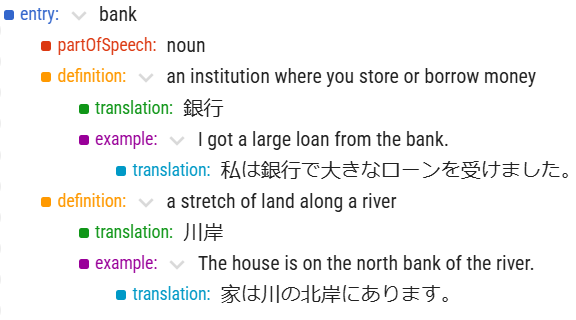Lexonomy uses NVH (Name-Value Hierarchy) as its native data format. It is a simple data format which does not use many special characters and, therefore, is easy to read and is also small in size. The image on the right shows the NVH data format displayed in the visual editor in Lexonomy.
NVH and XML
Data in XML can still be imported into Lexonomy and will be converted to NVH. Dictionaries built in Lexonomy will be in NVH but they can also be exported to XML.
Visual editor
Although entries and entry structure can be edited in raw NVH, it is not very practical and prone to error. Lexonomy contains an easy-to-use visual editor which prevents the user from inputting invalid NVH data.
Example only. Lexonomy allows both simpler and more complex structures, including user-defined structures and user-defined elements.
NVH explained
NVH is used both for setting the entry structure as well as during the editing of the entries. The visual editor in Lexonomy takes care of the correct syntax, but it is still useful for users to understand the very basics of this file format.
Elements
An element consists of a name (entry), a colon (:), a space ( ) and a value (bank). Each element must start on a new line. Dependent elements must be indented with two spaces.
raw NVH
entry: bank
partOfSpeech: noundisplayed in the visual editor in Lexonomy
Parent – child – sibling
An element can have dependent elements – children. A child can only exist if the parent element exists too. In the example on the right, the partOfspeech element can only exist with the entry element, not on its own. The example element can only exist with the definition element.
definitionis the parent oftranslation.translationandexampleare the children ofdefinition.translationis thesiblingofexample.Parent,childandsiblingare terms used in the editor interface.
raw NVH
entry: bank
partOfSpeech: noun
definition: an institution where you store or borrow money
translation: 銀行
example: I got a large loan from the bank.
translation: 私は銀行で大きなローンを受けました。
definition: a stretch of land along a river
translation: 川岸
example: The house is on the north bank of the river.
translation: 家は川の北岸にあります。displayed in the visual editor in Lexonomy
The colours are assigned to elements automatically. They make the editing more user-friendly. They do not show how the dictionary will be published. The styling of the dictionary for publication should be set in configuration.
Order of elements
The entry structure defines the elements but not their order. A dictionary entry is valid even if the order of elements is different from the entry structure. Some additional conditions apply.






